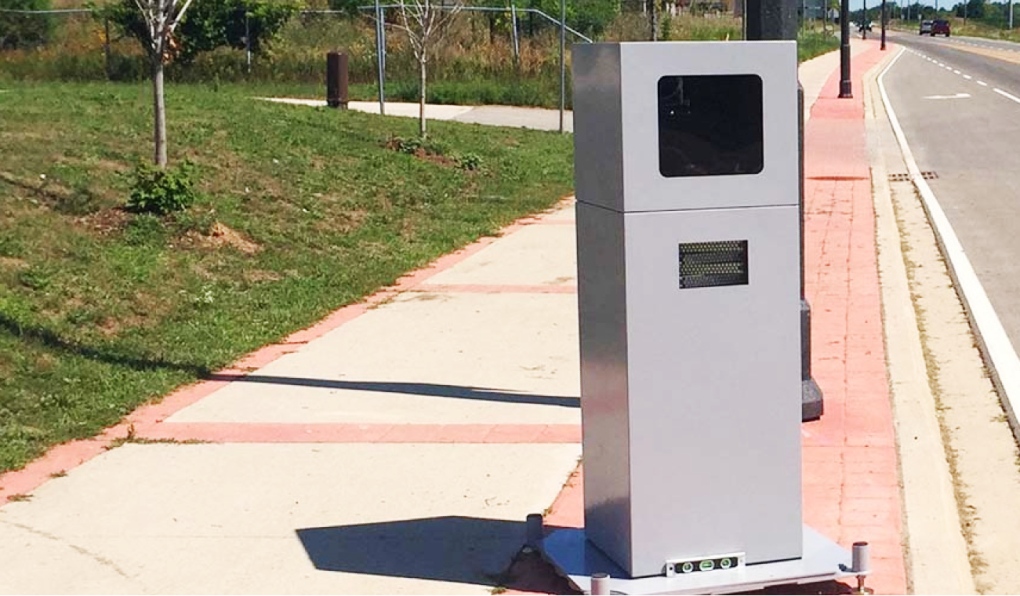Greater Sudbury’s six speed enforcement cameras will be moved to different locations
Greater Sudbury is adding to its arsenal of automated enforcement options with the addition of six speed enforcement cameras.
 Greater Sudbury is adding to its arsenal of automated enforcement options with the addition of six speed enforcement cameras. (Supplied/City of Greater Sudbury)The speed cameras are in addition to the red light cameras already operating in the city, and the automated licence plate scanners in use by police.
Greater Sudbury is adding to its arsenal of automated enforcement options with the addition of six speed enforcement cameras. (Supplied/City of Greater Sudbury)The speed cameras are in addition to the red light cameras already operating in the city, and the automated licence plate scanners in use by police.
The six speed enforcement cameras – which the city calls automated speed enforcement (ASE) -- will begin operating March 22, the city announced Wednesday.
“ASE is a cutting-edge solution designed to enhance the safety of our roadways,” a city news release said.
“The automated system uses a camera and a speed measurement device to detect and capture images of vehicles travelling more than the posted speed limit.”
Greater Sudbury Mayor Paul Lefebvre said in the release that the cameras improve safety on the roads.
“By holding motorists accountable and addressing the root causes of accidents related to speed, we hope to significantly reduce the number of traffic incidents and improve pedestrian, cyclist and motorist safety in our community,” Lefebvre said.
The first six locations across Greater Sudbury are:
- Bellevue Avenue (between Picard Street and Ralph Street)
- Algonquin Road (between Maurice Street and Field Street)
- Falconbridge Road (between Donnelly Drive and Church Street)
- Main Street, Val Caron (between Justin Street and MR 80)
- Hillcrest Drive (between Brian Street and Mikkola Road)
- Gary Avenue (between Lasalle Boulevard and Madison Avenue)
“Once the cameras are active, motorists photographed speeding through these areas will get a ticket,” the release said.
“Like speeding tickets issued by police officers, the fine amount will be based on how much the driver was exceeding the posted speed limit. If the offence occurred in a community safety zone, the fine will be doubled, even if it occurred outside of school hours.”
Tickets issued to vehicle owner
Similar to red light cameras, the tickets are issued to the owner of the vehicle, who is responsible for paying the fine regardless of who was actually driving.
“Tickets are mailed to the registered plate owner of the vehicle within 30 days,” the city said.
“No demerit points will be issued by the Ministry of Transportation and no one’s driving record will be impacted.”
“These cameras work to change driver behaviour which will help reduce serious injuries or deaths related to speed,” Tony Cecutti, the city’s GM of growth and infrastructure, is quoted as saying in the release.
“The expected behaviour is that there is no acceptable speed over the posted limit.”
- Download the CTV News app now
- Get local breaking news alerts
- Daily newsletter with the top local stories emailed to your inbox
The cameras will change locations every four months. Locations will be updated on the city’s website and shared via social media.
For more information including fine examples and how to pay fines, click here.
CTVNews.ca Top Stories

opinion Tom Mulcair: Prime Minister Justin Trudeau's train wreck of a final act
In his latest column for CTVNews.ca, former NDP leader and political analyst Tom Mulcair puts a spotlight on the 'spectacular failure' of Prime Minister Justin Trudeau's final act on the political stage.
B.C. mayor gets calls from across Canada about 'crazy' plan to recruit doctors
A British Columbia community's "out-of-the-box" plan to ease its family doctor shortage by hiring physicians as city employees is sparking interest from across Canada, says Colwood Mayor Doug Kobayashi.
'There’s no support': Domestic abuse survivor shares difficulties leaving her relationship
An Edmonton woman who tried to flee an abusive relationship ended up back where she started in part due to a lack of shelter space.
Baseball Hall of Famer Rickey Henderson dead at 65, reports say
Rickey Henderson, a Baseball Hall of Famer and Major League Baseball’s all-time stolen bases leader, is dead at 65, according to multiple reports.
Arizona third-grader saves choking friend
An Arizona third-grader is being recognized by his local fire department after saving a friend from choking.
Germans mourn the 5 killed and 200 injured in the apparent attack on a Christmas market
Germans on Saturday mourned the victims of an apparent attack in which authorities say a doctor drove into a busy outdoor Christmas market, killing five people, injuring 200 others and shaking the public’s sense of security at what would otherwise be a time of joy.
Blake Lively accuses 'It Ends With Us' director Justin Baldoni of harassment and smear campaign
Blake Lively has accused her 'It Ends With Us' director and co-star Justin Baldoni of sexual harassment on the set of the movie and a subsequent effort to “destroy' her reputation in a legal complaint.
Oysters distributed in B.C., Alberta, Ontario recalled for norovirus contamination
The Canadian Food Inspection Agency has issued a recall due to possible norovirus contamination of certain oysters distributed in British Columbia, Alberta and Ontario.
New rules clarify when travellers are compensated for flight disruptions
The federal government is proposing new rules surrounding airlines' obligations to travellers whose flights are disrupted, even when delays or cancellations are caused by an "exceptional circumstance" outside of carriers' control.

































